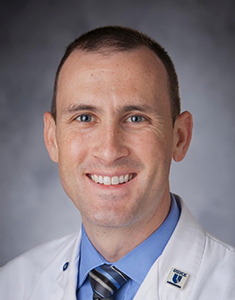
Each spring, after first-year medical students at Duke complete their clinical skills foundations course and begin building their diagnostic instincts, a small group of faculty and student leaders step in to offer something more: the opportunity to revisit the physical exam—not as a checklist, but as a diagnostic tool with real clinical meaning.
The Physical Diagnosis Interest Group (PDIG) is an informal, student-driven initiative designed to deepen physical exam skills through hands-on experience at the bedside. Although not an official Davison Council group, PDIG has been operating at Duke for about a decade. It continues to grow in popularity among students eager to translate their classroom learning into clinical practice.
Dr. John Roberts, associate professor of medicine and long-time faculty mentor for PDIG, helped launch the group nearly 10 years ago with then-medical student Dr. Dan Loriaux, now an interventional cardiology fellow at Duke.

“It was just a passion project,” said Dr. Roberts. “We wanted to teach more than just the motions of the physical exam—we wanted students to understand how to interpret findings, how to think critically at the bedside.”
Today, that mission continues with student leadership from the Careers in Internal Medicine Interest Group (CIMIGro). This year, PDIG events were organized by CIMIGro medical students and officers Meaghan O’Connor, Judah Kreinbrook, Annie Wang, Brooke Schroeder, and Becca Sullenger. The group meets on Tuesday evenings in the spring, strategically timed after students have been tested on the core physical exam.
“They’ve learned the basics,” O’Connor said. “Now we ask: how do you interpret the findings? What question are you trying to answer with each exam maneuver?”
Each session centers around a specific theme, like heart murmurs, neurologic exams, or signs of liver disease. Sessions typically start with a short teaching segment—sometimes covering evidence-based exam techniques or the diagnostic value of certain findings—before students head to the wards in small groups to see real patients with relevant conditions. Faculty mentors and student leaders guide the visits to ensure respectful, focused bedside learning.
The most ambitious session this year, called DiagnosED!, capped off the series. Students were paired with faculty or student leaders to evaluate and examine emergency department patients with an unknown problem or complaint. Next, they created visual teaching boards that summarized their patients' presentations, key features, and clinical reasoning processes. One week later, each student presented their findings to the group and revealed the patient’s actual diagnosis.
“It was one of the most rewarding nights,” O’Connor said. “They had to focus on what truly mattered in a sea of clinical information and think like diagnosticians.”
Kreinbrook, who has been helping with the effort since 2023, said he was drawn to the group immediately. “Much of the physical exam is shrouded in tradition, and our educational experiences are often left to chance,” he said. “The fact that we can help expose students to meaningful exam findings early in their training is, I think, really helpful.”
PDIG’s informal but intentional structure helps make this kind of learning possible. Attendance is voluntary, and groups are capped to protect patient comfort, but despite its low profile, the interest group fills quickly, a testament to what Dr. Roberts calls “the hunger students have to get out of the classroom and do something meaningful.”
For now, PDIG remains a passion project—built on the generosity of time, energy, and enthusiasm from its faculty and student leaders. But for the first-year students who participate, it can be a pivotal experience, offering a glimpse of clinical medicine in its truest form.
“Nothing replaces being at the bedside,” said Dr. Roberts. “That’s the real thing. That’s where students see, hear, and feel what makes medicine so powerful.”